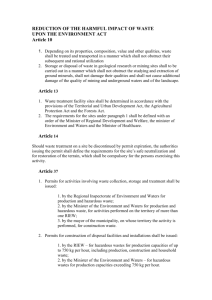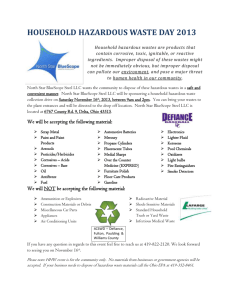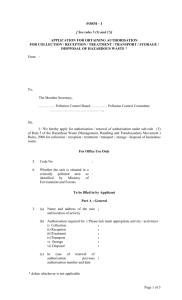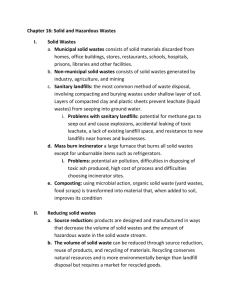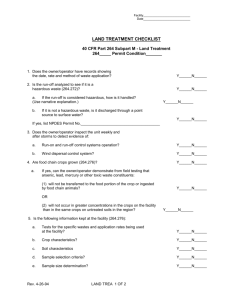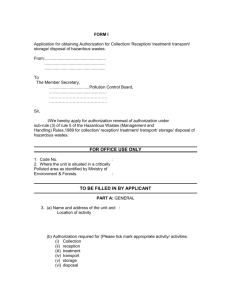Environmental Information Worksheet
advertisement
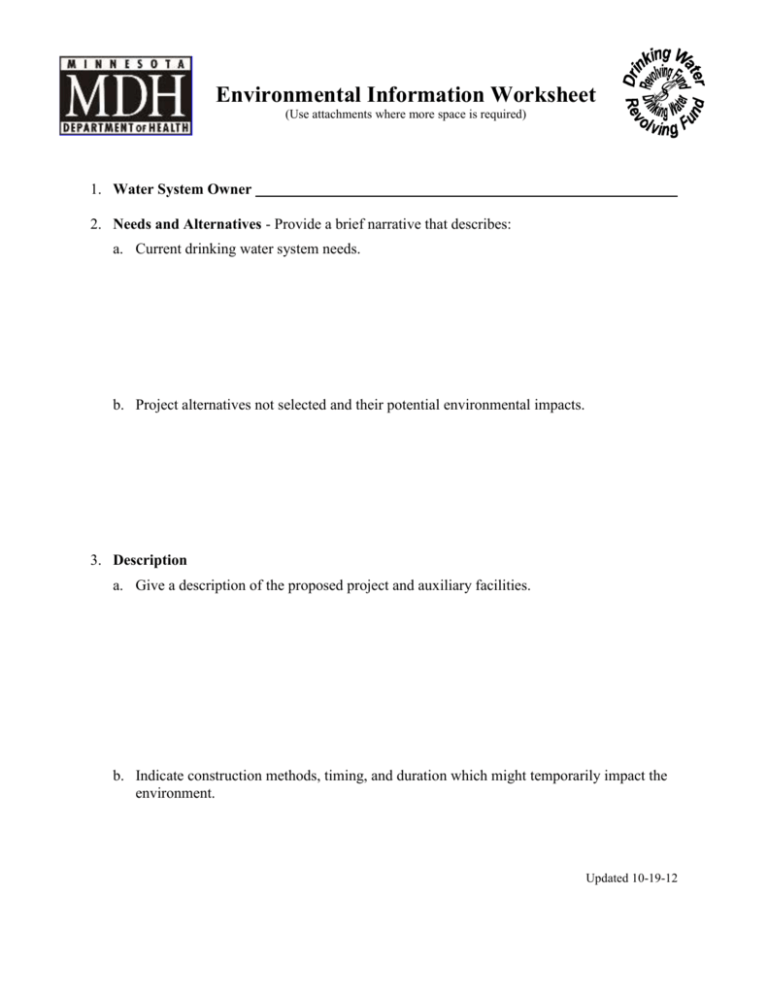
Environmental Information Worksheet (Use attachments where more space is required) 1. Water System Owner 2. Needs and Alternatives - Provide a brief narrative that describes: a. Current drinking water system needs. b. Project alternatives not selected and their potential environmental impacts. 3. Description a. Give a description of the proposed project and auxiliary facilities. b. Indicate construction methods, timing, and duration which might temporarily impact the environment. Updated 10-19-12 4. Project Location County City / Township ¼ ¼ Section Township Range Attach Copies of each of the following: a. Copy of U.S. Geological Survey 7.5 minute, 1:24,000 scale map or equivalent (photocopy is acceptable) indicating the project boundaries; b. site plan showing all significant project and natural features; and c. If needed for clarification, a county map showing the general location of project. 5. Project Magnitude Data Total project area (acres) and/or total and/or length (feet or miles) square feet. 6. Permits and Approvals Required List all known local, state, and federal permits, approvals and funding required. Unit of Government Type of Application Status 7. Land Use Describe current and recent past due land use and development on the site and on adjacent lands. Discuss project compatibility with adjacent and nearby land uses. Indicate whether and potential conflicts involve environmental matters. Identify and potential environmental hazard due to past land uses, such as soil contamination or abandoned storage tanks or proximity to nearby hazardous liquid or gas pipelines. 8. Cover Types Estimate the acreage of the site with each of the following cover types before and after development (before and after totals should be equal): Before After Type 1 to 8 Wetlands Wooded / Forest Brush / Grassland Crop Land Lawn / Landscaping Impervious Surface Other (describe) 9. Fish, Wildlife and Ecologically Sensitive Resources a. Identify fish and wildlife resources on or near the site and discuss how they would be affected by the project. Describe any measures to be taken to minimize or avoid adverse impacts. b. Are any state listed endangered, threatened or special-concern species; rare plant communities or other sensitive ecological resource such as native prairie habitat, colonial waterbird nesting colonies or regionally rare plant communities on or near the site? Yes No If yes, describe the resource and how it would be affected by the project. Indicate if a site survey of the resources was conducted and describe the results. Describe measure to be taken to minimize or avoid adverse impacts. 10. Physical Impacts on Water Resources Will the project involve the physical or hydrologic alteration (dredging, filling, stream diversion, outfall structure, diking, and impoundment) of any surface water (lake, pond, wetland, stream, drainage ditch)? Yes No If yes, identify water resources affected and give the Minnesota Department of Natural Resources (DNR) Protected Waters Inventory number(s) if the water resources affected are on the PWI: . Describe alternatives considered and proposed mitigation measures to minimize impacts. 11. Water Use a. Will the project involve the installation or abandonment of any wells? Yes No b. Will the project require an appropriation of ground or surface water (including dewatering)? Yes No If yes, indicate the source, quantity, duration, purpose of the appropriation, and the DNR water appropriation permit number of any existing appropriation. Discuss the impact of the appropriation on ground water levels. 12. Water-related Land Use Management Districts Does any part of the project site involve a shoreland zoning district, a delineated 100-year flood plain or a state or federally designated wild or scenic river land use district? Yes No If yes, identify the district and discuss the compatibility of the project with the district land use regulations. 13. Erosion and Sedimentation Give the acreage to be graded or excavated and cubic yards of soil to be moved: acres; cubic yards. Describe any steep slopes or highly erodible soils and identify the on the site map. Describe the erosion and sedimentation measures to be used during and after construction of the project. 14. Water Quality – Surface Water Runoff a. Compare the quantity and quality of site runoff before and after the project. Describe methods to be used to manage or treat runoff. Describe any stormwater pollution prevention plans. b. Identify route(s) and receiving water bodies for runoff from the site. Estimate the impact of runoff on the quality of receiving waters. 15. Water Quality – Wastewaters a. Describe sources, quantities and composition (except for normal domestic sewage) of all sanitary and industrial waterwaters produced or treated at the site. b. Describe waste treatment methods or pollution prevention efforts and give estimates of composition after treatment. Identify receiving waters, including major downstream water bodies and estimate the discharge impact on the quality of the receiving waters. If the project involves on-site sewage systems, discuss the suitability of site condition. c. If wastes will be discharged into a publically owned treatment facility’s ability to handle the volume and composition of wastes. Identify any improvements necessary. 16. Geological Hazards and Soil Conditions a. Approximate depth (in feet) to: ground water: minimum: average: bedrock: minimum: average: b. Describe any of the following geological site hazards to ground water and also identify them on the site map: sinkholes, shallow limestone formations or karst conditions. Describe measures to avoid or minimize environmental problems due to any of these hazards. c. Describe the soils on the site, giving Soil Conservation Service classifications, if known. Discuss soil granularity and potential for groundwater contamination from wastes or chemicals spilled on the soils. Discuss mitigation measures to prevent contamination. 17. Solid Wastes; Hazardous Wastes; Storage Tanks a. Describe types, amounts and composition of solid or hazardous wastes, including sludge and ash. Identify method and location of disposal. For projects generating municipal solid waste, indicating if there will be a source separation plan. If hazardous waste is generated indicate if there is a hazardous waste minimization plan and routine hazardous waste reduction assessments. b. Identify any toxic or hazardous materials to be used or present at the site and identify measures to be used to prevent them from contaminating groundwater. c. Indicate the number, location, size and use of any above or below ground tanks to store petroleum products or other materials (except water). 18. Stationary Source Air Emissions Will the project involve any stationary sources of air emissions (such as boilers or exhaust stack)? Yes No If yes, describe the sources, quantities and composition of the emissions; the proposed air pollution control devices; the quantities and composition of the emissions after treatment and the effects on air quality. 19. Odor, Noise and Dust Will the project generate dust, odors or noise during construction and/or operation? Yes No If yes, describe sources, characteristics, duration, quantities or intensity and any proposed measures to mitigate adverse impacts. Also, identify locations of nearby sensitive receptors and estimate impacts on them. 20. Resources Are any of the following resources on or in proximity to the site: a. Archaeological, historical or architectural resources?* Yes No b. Prime or unique farmlands or land within an agricultural preserve? Yes No c. Designated parks, recreation areas or trails? Yes No d. Scenic views and vistas? Yes No e. Other unique resources? Yes No *Any project requiring an environmental review must state in the solicitation letter to the State Historic Preservation Office (SHPO) that a National Historic Preservation Act Section 106 review is required. A copy of the solicitation letter to SHPO must be provided. If it is determined that any historic sites or structures will be impacted, an agreement must be reached with the State Historic Preservation Office, MDH, and the project submitter before funding can be received. A copy of the agreement must be attached. If yes, describe the resource and identify any project-related impacts on the resources. Describe any measures to minimize or avoid adverse impacts. 21. Compatibility with Plans Is this project subject to an adopted local comprehensive plan, land use plan or regulation or other applicable land use, water or resource management plan of a local, regional, state or federal agency? Yes No If yes, describe the plan, discuss its compatibility with the project and explain how any conflicts will be resolved. If no, explain. 22. Impact on Infrastructure and Public Services Will new or expanded utilities, roads, other infrastructure or public services be required to serve the project? Yes No If yes, describe the new or additional infrastructure or services needed. 23. Related Developments; Cumulative Impacts a. Are future stages of this development planned or likely? Yes No If yes, briefly describe future stages, their timing and plans for environmental review. b. Is this project a subsequent stage of an earlier project? Yes No If yes, briefly describe the past development, its timing and any past environmental review. c. Is this development anticipated on adjacent land? Yes No If yes, briefly describe the development and its relationship to the present project. 24. Other potential Environmental Impacts If the project may cause any adverse environmental impacts not addressed in Items 1 through 23 on this worksheet, identify and discuss them here, along with any proposed mitigation. 25. Summary of Issues List any impacts and issues identified that may require further investigation before the project is begun. Discuss any alternatives or mitigative measures that have been or may be considered for these impacts and issues, including those that have been or may be ordered as permit conditions. Updated 10-19-12

